|
Limitar tu búsqueda
[+–] Compilador o editor
[+–] Creator
- Aguayo Tellez, Ernesto (2)
- Aguilera, Nelly (1)
- Ayala Gaitán, Edgardo A. (2)
- Campos Vázquez, Raymundo M. (2)
- Castellanos, Sara G. (2)
- Chapa Cantú, Joana Cecilia (1)
- Conferencia Interamericana de Seguridad Social (14)
- Conferencia Interamericana de Seguridad Social. Secretaría General (2)
- Cuijpers, Pim (1)
- Cuilty, Emilio (2)
- De la Torre, Rodolfo (2)
- Gameren, Edwin van (1)
- Gutiérrez, Cristina (1)
- Hernández Ángeles, Domingo F. (2)
- Jayawardena, Priyanka (2)
- Jonkman, Harrie (1)
- Lima, Martín (1)
- Lorant, Vincent (2)
- López Rodríguez, Patricia (4)
- Maceira, Daniel (1)
- Manuel Gutiérrez, Diana (2)
- Martínez Cárdenas, Rubén (2)
- Martínez, Gabriel (4)
- Mejía, Daniela (1)
- Meneses, Karla (2)
- Merino Sanz, María (2)
- Millán Quijano, Jaime A. (1)
- Miranda, Martha (4)
- Morales, F. Javier (2)
- Moreno-Brid, Juan Carlos (3)
- Murrugara, Edmundo (1)
- Organización de Estados Americanos. Depto de Inclusión Social de la Sria Ejecutiva para el Desarrollo Int. de la OEA (1)
- Ortega, Daniel (1)
- Padilla Pérez, Ramón (3)
- Ramírez Medina, Edgar (2)
- Rangel Pérez, Cindy Paola (1)
- Robison, Lindon J. (2)
- Sandoval, Héctor H. (1)
- Schreiner, Mark (2)
- Scott, John (1)
- Siles, Marcelo E. (2)
- Soloaga, Isidro (4)
- Soto, Victoria Eugenia (2)
- Torán, Mariana A. (2)
- Twisk, Jos (1)
- Vargas Chanes, Delfino (2)
- Zaragoza Castillo, Ricardo (2)
[+–] Editorial
[+–] Fecha
[+–] Formato
[+–] Idioma
[+–] Tipo de documento
[+–] Tipo de recurso
[+–] Classification
|

|
|
Informe sobre la seguridad social en América 2013: 10 años fortaleciendo el bienestar de los ciudadanos en América
Este Informe sobre la Seguridad Social en América es un resumen y recapitulación de temas que están presentes en los principales debates que se han analizado durante la década anterior. Actualmente, se tiende a identificar que las décadas de los ochenta y de los noventa fueron épocas de reformas en la región, desde Norteamérica y el Caribe hasta el Cono Sur. Sin embargo, en realidad todavía en la...
|

|
|
|
|

|
|
MSMES in Costa Rica: Chronicle of their poor integration in times of accelerated international integration
El presente documento, está centrado en las Mipyme y en las políticas públicas para su fomento en la economía costarricense. El análisis, se hace a partir de un enfoque alternativo de clasificación de las actividades económicas, el cual permite precisar con mayor detalle las desigualdades entre las actividades tradicionales de amplia trayectoria en la economía, de aquellas actividades que han...
|

|
|
|
|

|
|
Different worlds, common roots a multilevel analysis of youth violence and delinquency in the netherlands antilles as a basis for crime prevention
Most research on the prevalence, determinants, and variations of violence and delinquency among youngsters is conducted in Western societies. This multilevel study is set in the Netherlands Antilles (NA) and aims to build up prognostic multilevel models as a basis for targeted crime prevention in a non-western area. Data were collected from a sample of adolescente in the NA. Non-hierarchical and...
|
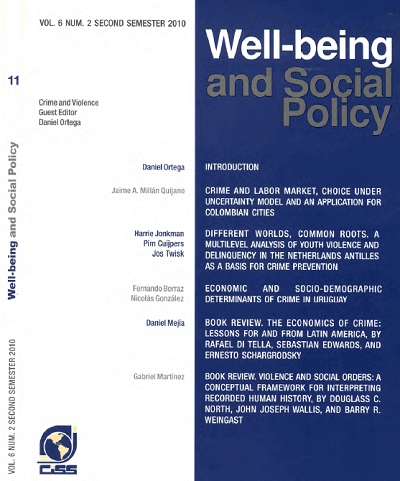
|
|
|
|

|
|
Book review. The economics of crime: lessons for and from Latina America, by Rafael Di Tella, Sebastian Edwards, and Ernesto Schargrodsky
The Economics of Crime: Lessons for and from Latin America makes an important contribution to the study of crime and violence in Latin America and to the debate about what works for reducing crime (and at what cost?). As the title of the book correctly suggests, the book brings together contributions from Latin American economists on the determinants and consequences of crime, as well as...
|
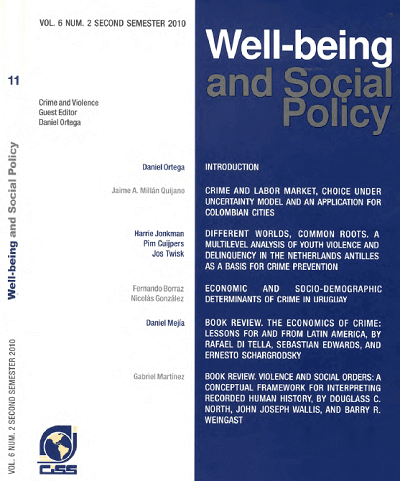
|
|
|
|

|
|
Book review. Violence and social orders: a conceptual framework for interpreting recorded human history, by Douglas C. North, John Joseph Wallis, and Barry R. Weingast
Why societies differ in their level of violence? This is the question addressed by North, Wallis, and Weingast. To provide an answer they must develop a rich theory of how individuals and organizations that compose a human group voluntarily surrender their will to act violently in exchange for participating in a society with improved conditions for the creation and conservation of wealth.
|
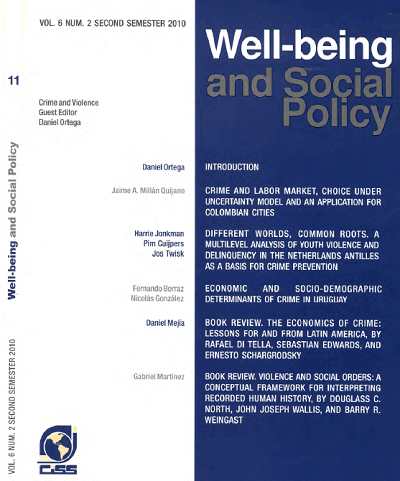
|
|
|
|

|
|
The health insurance reform in the Netherlands and its relevance for Mexico
Alrededor del mundo se observan dos versiones de la organización de los seguros de salud; la seguridad social basada en el empleo, y los servicios nacionales de salud. En Latinoamérica regularmente se usa la primera, pero se está lejos de lograr la cobertura universal. En los Países Bajos encontramos una peculiar mezcla de obligaciones públicas y responsabilidades privadas. La cobertura universal...
|

|
|
|
|

|
|
Feasibility analysis of an integrated health system: financial and distributive implications
The document presents spending projections and projections of the distributive incidence for an Integrated Health System under three basic scenarios: status quo, a two pillar scheme (financed through general taxes and private spending) and a three pillar scheme (financed through general taxes, social security contributions and private spending). By presenting these simulations, the study enhances...
|
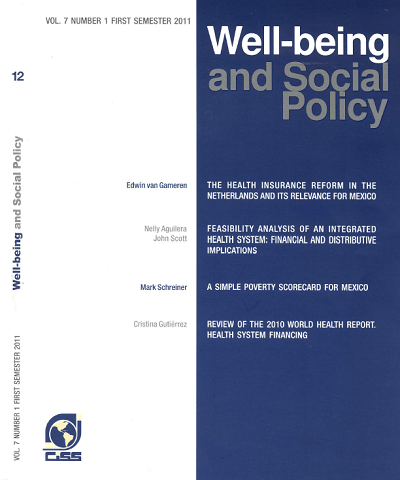
|
|
|
|

|
|
A simple poverty scorecard for Mexico
This study uses Mexico's 2008 National Household Survey of Income and Expenditure to I construct an easy-to-use scorecard that estimates the likelihood that a household has income below a given poverty line. The scorecard uses ten simple indicators that field workers can quickly collect and verify. Poverty scores can be computed on paper in the field in about five to ten minutes. The scorecard's...
|
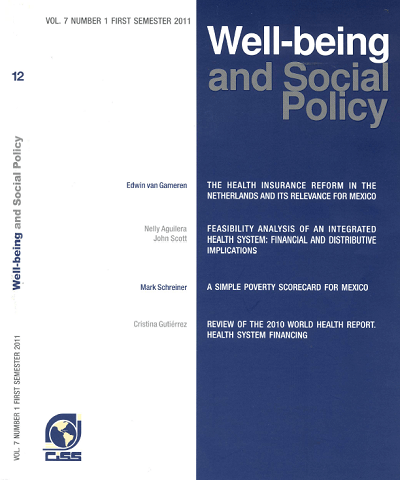
|
|
|
|

|
|
Promised and actual benefits in mexican social security fot rhe transtion generation
Este artículo presenta un conjunto de mediciones de los costos y beneficios reales del plan general de retiro por jubilación proporcionado a los ciudadanos por parte del Sistema Mexicano de Pensiones (SMP), que son necesarias para evaluar las decisiones de los trabajadores en cuanto a la contribución a la seguridad social (es decir, trabajar en el sector formal) y al retiro. El SMP ofrece dos...
|

|
|
|
|

|
|
Social security pensions and retirement decisions in Mexico
Using Mexican cohort data for 1991-2000 this article examines the relationship between retirement decisions —the transition from work to labor market inactivity— and social security (contributive) pensions in less developed countries. The available large time series also makes possible to examine how a financial crisis that took place in 1995 has affected retirement incentives. In most Latin...
|

|
|
|
|

|
|
Socio-economic determinants and inequalities in childhood malnutrition in Sri Lanka
Despite countless initiatives to alleviate malnutrition over the years, it affects hundreds of thousands of children in Sri Lanka. Understanding the determinants of malnutrition and their contribution to socio-economic inequality in malnutrition is essential in targeting specific socio-economic groups to improve their nutrition levels. This study attempts to identify the socio-economic...
|
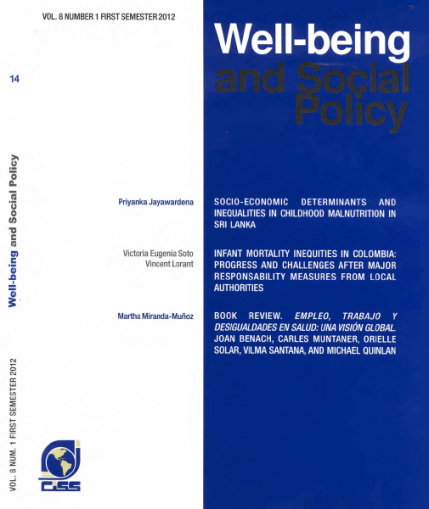
|
|
|
|

|
|
Infantil mortality inequities in Colombia: Progress and challenges after major responsability measures from local authorities
This paper aims to analyse the space and time distribution of the infant mortality rate (IMR) at municipality level in Colombia before and after conferring greater responsibilities to the municipalities for the administration of the local health care systems. Using special econometrics, we find that there is a geographical concentration of IMR persisting over time and defining two groups of...
|

|
|
|
|

|
|
Book review. Empleo, trabajo y desigualdades en salud: una visión global. Joan Benach, Charles Muntaner, Orielle Solar, Vilma Santana y Michael Quinlan
This is a stimulating book which explores the relationship between employment conditions and health outcomes. The authors provide a conceptual framework to illustrate the channels through which health outcomes are determined and affected; this framework includes individual and aggregate variables, such as the economic, political and environmental conditions. The book also includes case studies...
|
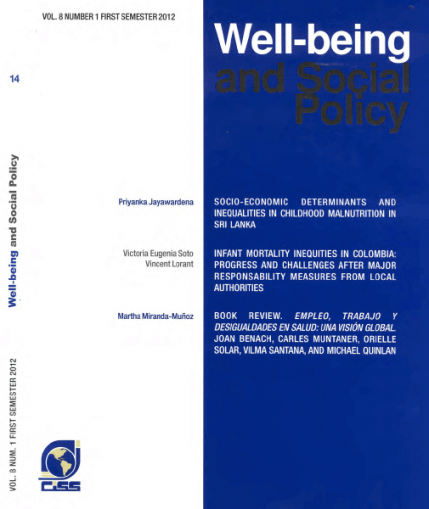
|
|
|
|

|
|
Introduction (On the issues addressed by this issue of the journal)
Micro and small-sized enterprises (MSE) have a central role in economic development in Latin America given their large contribution to employment generation, their share in the total number of firms and, to a lesser extent, their contribution to gross domestic product. Yet, their production is mainly oriented to the domestic market and they are characterized by an increasing productivity gap with...
|
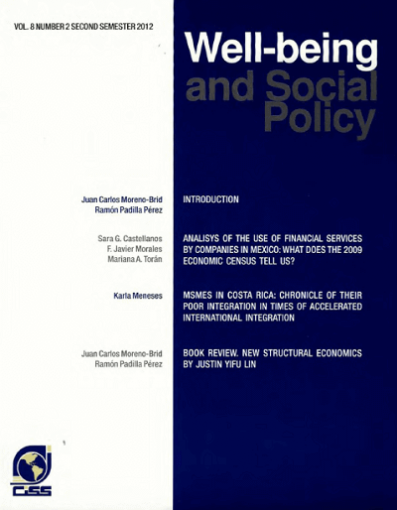
|
|
|
|

|
|
Analysis of the use of financial services by companies in Mexico: What does the 2009 Economic Census tell us?
We present a descriptive analysis of the results of Mexico's 2009 Economic Census regarding the use of bank credit and accounts by productive entities (companies). INEGI was requested to prepare a set of statistics regarding various company characteristics that are relevant to the decisions made by institutions offering banking services. Information was grouped according to company size and to...
|
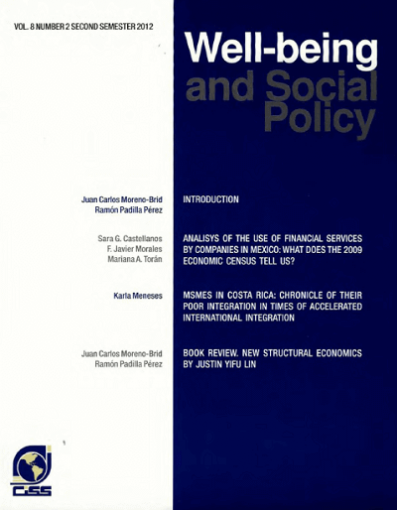
|
|
|
|

|
|
Introduction (On the issue of social capital that is addressed in this issue of the journal)
In recent decades, interest has increased in identifying, estimating and linking social capital to a variety of well-being variables in which the production of certain benefits or performance is key. Research has involved the confluence of several disciplines: economics, sociology, anthropology and psychology, to name a few. Although consensus on the definition of a single indicator for measuring...
|
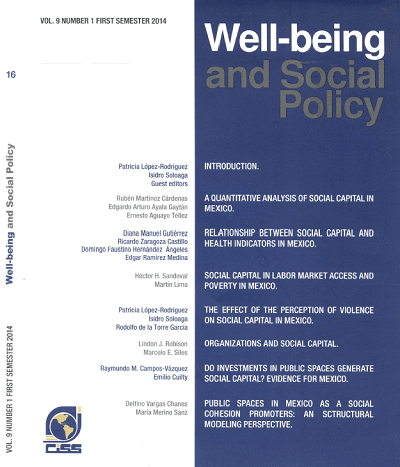
|
|
|
|

|
|
Introduction (On the studies presented at the International Conference on "Delinquency and Violence in Latin America and the Caribbean")
Crime has become the leading concern for citizens of the region and has been pushed to the forefront of the international policy agenda; what is more, the combination of very few success stories and abundant failures in curbing crime and violence has underscored how thin our understanding is and the difficulty of designing and implementing an effective strategy at the local level. This issue...
|

|
|
|
|

|
|
A quantitative analysis of social capital in Mexico
Se ha relacionado el capital social a la eficiencia en los mercados (Arrow, 1972), al refuerzo del contrato (Durlauf y Fafchamps, 2004) y en general al desarrollo y bienestar (Keefer y Knack 1997; Putnam 2000; Knack y Zak 2003). En el presente trabajo hemos investigado los determinantes del capital social empíricamente, centrándose en tres medidas comunes aproximadas de este: dos ligadas a la...
|

|
|
|
|

|
|
Relationship between social capital and health indicators in Mexico
This study analyzes the relationship between social capital types and access to health services in Mexico. To this end, access to healthcare data from the 2006 ENCASU and 2011 ENCAS was validated using 2006 and 2012 ENSANU results. Indicators were found to be consistent. A statistical analysis of the distribution of social capital and health indicators by region, as well as by rural or urban area...
|
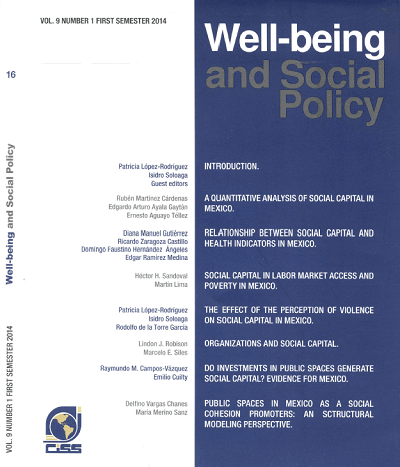
|
|
|
|

|
|
Social capital in labor market access and poverty in Mexico
Social capital, defined as the set of social networks that a person has in order to obtain benefits, is used by the population as a mechanism for providing resources, to cushion shocks in consumption and to obtain information on available employment opportunities. This study employs a logistic model to characterize the manner in which people access the labor market in Mexico through the use of...
|

|
|
|
|
|